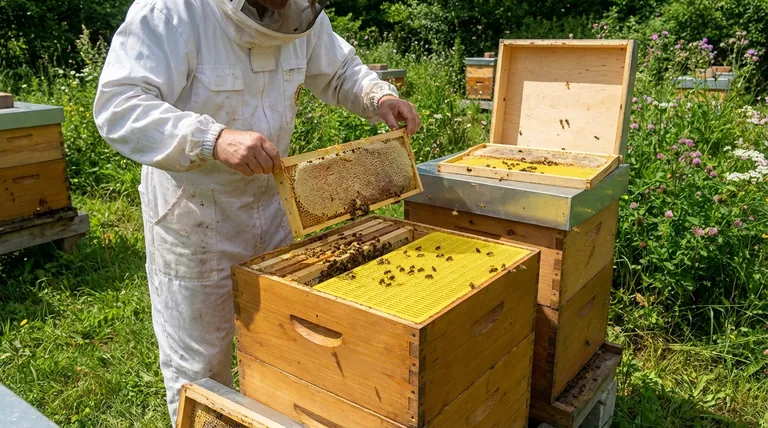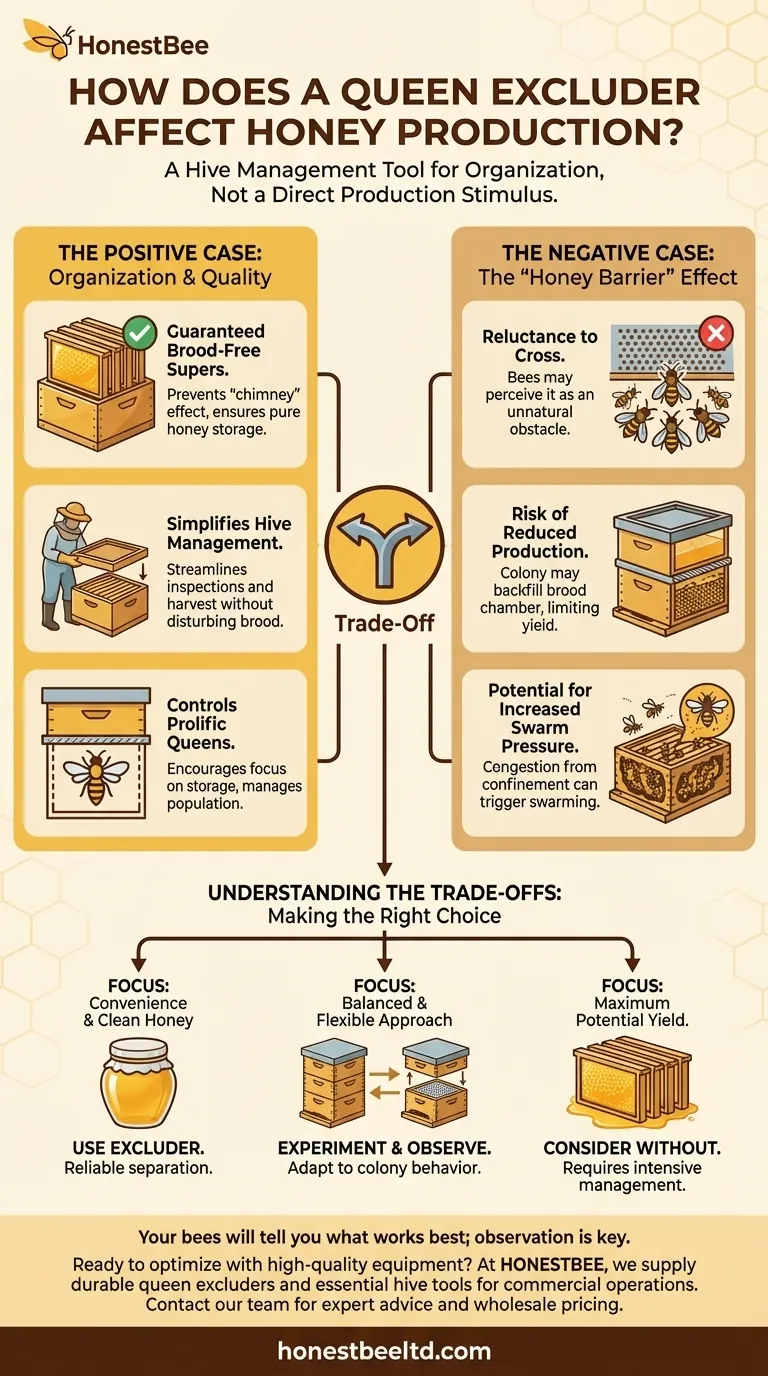At its core, a queen excluder's effect on honey production is not straightforward; it can either reduce the total yield or indirectly support a larger, cleaner harvest. The outcome depends entirely on the specific colony's behavior and the beekeeper's management goals. It does not magically create more honey but serves as a tool to organize the hive, which can have secondary effects on the final yield.
A queen excluder is best understood as a hive management tool for ensuring honey quality and simplifying extraction, not as a direct stimulus for honey production. Its primary benefit is convenience and hive organization, which comes with the potential trade-off of a lower total honey yield if the colony is reluctant to work through it.

The Fundamental Purpose of a Queen Excluder
A queen excluder is a perforated screen, typically made of metal or plastic, placed between the hive's brood boxes and the honey collection boxes (supers).
How It Works
The gaps in the excluder are engineered to be between 4.1 and 4.4 millimeters. This precise sizing allows the smaller worker bees to pass through into the honey supers while blocking the larger queen and drones from entering.
The Goal: A Clean Honey Harvest
The excluder's main function is to confine the queen to the brood chamber. This ensures she only lays eggs in the lower boxes, dedicating the upper supers exclusively for honey storage. This separation results in honey frames that are free of eggs, larvae, and pupae, leading to a much cleaner and more straightforward extraction process.
The Positive Case: Organization and Quality
When a colony readily accepts an excluder, beekeepers gain significant advantages in hive management and honey quality.
Guaranteeing Brood-Free Supers
By keeping the queen out of the honey supers, you ensure every cell is available for nectar storage. This prevents a "chimney" effect where the queen moves upward, creating a column of brood that interrupts honey storage patterns and complicates the harvest.
Simplifying Hive Management
An organized hive is easier to manage. Knowing that all brood-rearing is contained in the lower boxes allows you to inspect and manipulate the honey supers without disturbing the colony's nursery. This streamlines inspections and honey collection.
Controlling Prolific Queens
Some genetic lines of bees, particularly wild-caught or Africanized strains, are predisposed to massive brood production. An excluder can help manage this tendency, encouraging a colony that might otherwise prioritize population growth to focus more on honey storage.
The Negative Case: The "Honey Barrier" Effect
The most significant argument against queen excluders stems from the behavioral changes they can induce in some colonies.
Reluctance to Cross the Barrier
For reasons that are not fully understood, some colonies are hesitant to pass through the excluder. The worker bees may perceive it as an unnatural obstacle, creating a psychological barrier.
This phenomenon is sometimes called the "honey barrier", where bees are more likely to store honey in the brood chamber rather than travel up into the supers.
The Risk of Reduced Production
If bees are unwilling to move into the honey supers, they will not fill them. This directly reduces the potential honey harvest. The colony may instead backfill the brood chamber with nectar, limiting the queen's laying space and potentially triggering a swarm.
Potential for Increased Swarm Pressure
By confining the queen to the lower boxes, an excluder can lead to congestion if not managed properly. A crowded brood nest is a primary trigger for swarming. If the bees also refuse to move up, the problem is compounded, increasing the likelihood the colony will swarm and reducing your workforce just before a major honey flow.
Understanding the Trade-offs
The decision to use a queen excluder is a classic beekeeping trade-off between convenience and potential production.
Convenience vs. Maximum Yield
Using an excluder provides the near-guarantee of clean, easy-to-harvest honey. Foregoing one may lead to a higher total yield if the colony works more vigorously, but it requires you to be more diligent in managing the queen's location and dealing with potential brood in your honey frames.
Colony Behavior is Paramount
As the research suggests, the impact varies by colony. A gentle, locally-bred colony may not need an excluder to keep a tidy nest. A more aggressive or prolific colony might benefit greatly from the containment. Observation is your most valuable tool.
Mitigating the Downsides
If you use an excluder and notice hesitation from the bees, you can try creating a small upper entrance above the excluder. This gives foraging bees a direct path into the honey supers, reducing traffic across the barrier and encouraging them to work in the upper boxes.
Making the Right Choice for Your Goal
Ultimately, there is no single "correct" answer. Your strategy should align with your beekeeping philosophy and objectives.
- If your primary focus is convenience and guaranteed clean honey: Use a queen excluder. It is the most reliable tool for separating brood from your honey harvest.
- If your primary focus is maximizing potential honey yield: Consider managing your hives without an excluder, but be prepared for more intensive management to prevent swarming and handle brood in the supers.
- If your primary focus is a balanced, flexible approach: Experiment with your hives. Use an excluder on some but not others, or introduce it only during the peak nectar flow to guide the bees upward before removing it.
Your bees will tell you what works best; the most successful beekeepers are those who learn to listen.
Summary Table:
| Pros of Using a Queen Excluder | Cons of Using a Queen Excluder |
|---|---|
| Guarantees brood-free honey supers | Can create a 'honey barrier' if bees are reluctant |
| Simplifies hive management and inspection | May reduce total honey yield in some colonies |
| Controls prolific queens and prevents swarming | Potential for increased swarm pressure if not managed |
| Ensures clean, easy honey extraction | Requires careful observation of colony behavior |
Ready to optimize your honey production with the right equipment?
At HONESTBEE, we supply commercial apiaries and beekeeping equipment distributors with high-quality, durable queen excluders and other essential hive tools. Our wholesale-focused operations ensure you get the reliable gear you need to manage your colonies effectively, whether your goal is maximum yield or pristine honey quality.
Let's discuss how our equipment can support your specific beekeeping goals. Contact our team today for expert advice and wholesale pricing!
Visual Guide

Related Products
- Professional Plastic Queen Excluder for Modern Beekeeping
- High Performance Plastic Queen Excluder for Beekeeping and Apiary Management
- HONESTBEE 6 Frame Three Use Electric Honey Extractor for Beekeeping
- Wooden Queen Bee Excluder for Beekeeping
- electric honey extractor honey centrifuge 3 frame honey extractor stainless steel honey frame extractor
People Also Ask
- What are the pros of using a queen excluder? Boost Hive Control & Honey Quality
- What is the primary function of a queen excluder in beekeeping? Control Hive Layout for Efficient Honey Harvesting
- What are the main advantages of using a queen excluder in beekeeping? Simplify Hive Management & Harvest
- What is a Queen Excluder and how does it work? Achieve Purer Honey & Better Hive Control
- What is the role of a queen excluder when adding a super? Ensure Brood-Free Honey Harvests



















